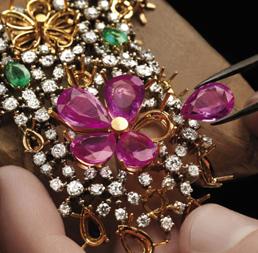Franchising, retail, business

07/12/2015
Tens of millions of euros invested, a new plant in the heart of the Piedmontese jewelry district: Bulgari is set to triple its production capacity and turn Valenza into the largest jewelry manufacturing area in Europe.
In Valenza, Bulgari CEO Jean-Christophe Babin announced the plant’s inauguration in the fall of 2016. Bulgari expects to hire 300 more people once the factory is up and running, increasing the present fold of 380. They will also inaugurate the first ever Bulgari Academy, training their highly specialized workforce.
“We have chosen a green-field investment to increase our production capacity and optimize our manufacturing process,” said Babin. An ambitious project “that combines production and creativity and symbolizes the proactive energies at work in Italy;” such as in “the machinery district in Modena, leather in Florence, silk in Como,” areas that provide healthy exports and top-quality product. The new Bulgari plant is part of this aspect of Italy, “whose creative talent and craftsmanship have made the country’s reputation”.
The project’s rendering shows a 14,000+ square-meter structure behind a historic farmhouse that once housed the first goldsmith’s workshop in Valenza. Three floors, one of them underground, a courtyard onto which open the company restaurant and offices, and a sort of metal ’skin’ that protects the factory without blocking the light, ensuring better insulation and lower energy consumption. So far, Bulgari – historic brand in Italian jewelry that now belongs to the French LVMH Group – had two production centers in the Alessandria province, both of which have reached saturation point.
Investing in Italy, said Babin, responds to the imperative need to concentrate production in a modern plant with high standards of environmental sustainability, looks to the next decade in terms of production volume and potential market growth and guarantees Bulgari a “thirty-year” perspective onto the future after a record year, as Babin defined it, when the brand performed better than the sector’s average.
Also thanks to a great combination of iconic collections like the serpent and B.zero1 rings (the series, created in the late 1990s, has something new in store for next year) and a creative, innovative stage that saw the launch of the Diva range and the new women’s watches; and to the fact that “Europeans have resumed purchases” in the luxury and impulse buying segment – like jewelry – “after a stretch in 2013-2014 when they had lagged behind” the Chinese, who top the list to this day, together with Asians in general, Americans and the Middle East.
Bulgari is going to focus production of all collections in Valenza, from entry-level to the medium-high segment, while all of the haute joaillerie or luxury jewelry will continue to be produced in the Bulgari workshop in Rome. One of the strong points of investing in Valenza – together with the investments of recent years on forty Bulgari retail stores, starting with via Condotti, to make them increasingly exclusive – is that the new plant will ensure greater speed and efficiency in production, making it possible to vary and mix volumes and products in real time, both more and less labor-intensive. Production capacity will be enhanced, reflecting the challenge of a growing market.
Asked what he thought of Italy’s competitiveness, Babin’s response was crystal-clear: “Italy’s historic heritage in top-quality products has managed to grow and go global, thanks to the ability to combine technological mastery, craftsmanship, creativity and design. As in the goldsmith’s art”.
Fonte:http://www.italy24.ilsole24ore.com/art/business-and-economy/2015-12-04/bulgari-triples-valenza-da-passare-150743.php?uuid=ACS70MnB&cmpid=nlqii